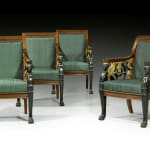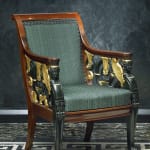Unknown
A superb set of four Russian Empire parcel-gilt mahogany open fauteuils, each with a rectangular padded back and drop-in seat covered in close-nailed patterned green horse hair, the stiff leaf carved tablet above shaped arms with winged female monopodiae supports issuing pierced foliage and terminated by lion paw feet, each with an ink stamp G T beneath a crown and inscribed G and numbered 34
Saint-Petersburg, date circa 1820
Height 93 cm, width 62 cm, depth 58.5 cm. each.
The superb rinceau and the scrolling foliate carved decoration on these well-proportioned Russian Empire fauteuils are characteristic of chairs made at Saint-Petersburg during the early years of the nineteenth century. In particular they relate to seat furniture designed for the refurbishment of Pavlovsk Palace after a fire destroyed much of the original decoration in 1803. Two spectacular armchairs at Pavlovsk, designed by the artist and architect Andreï Voronikhin (1759-1814), made in 1804 for the Grecian Hall and the Empress Maria Feodorovna's boudoir respectively are similarly decorated with bronzed mahogany eagle-headed monopodiae front legs while carving to the back panels shows a related pierced scrolling foliate carved field (illustrated in E Ducamp, ed. "Pavlovsk - The Collections", 1993, p. 111, pls. 24-25).
The similarity in design of the winged female monopodiae supports with those appearing on French-made chairs and other furniture is no coincidence since it was to Paris that Russia drew its main inspiration during the late eighteenth and early nineteenth centuries. Indeed Voronikhin travelled to Paris, where he not only studied furniture but also bronzes and other works of art. While there he would have become well aware of similar chairs executed by the leading ébénistes Georges Jacob (1739-1814) and his two sons, Georges II (1768-1803) and François-Honoré-Georges (1770-1841), whose work was often based on designs by Napoleon's chief architects Charles Percier (1764-1838) and Pierre François Léonard Fontaine (1762-1853). Percier and Fontaine's "Receuil de Décorations Intérieurs", published in 1801, included various detailed designs for chairs with such supports and these were disseminated throughout Europe and were also accessible to craftsmen working in Saint-Petersburg.



